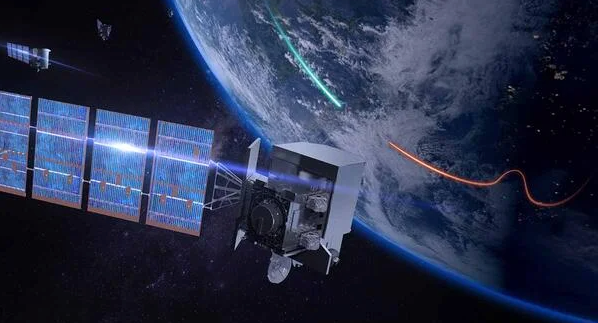L3Harris Pursuing Early Materials Acquisition for SDA Tracking Layer Satellites

The fiscal year 2022 defense appropriations law provided $550 million for the Space Development Agency (SDA) to accelerate development of the Tracking Layer to support U.S. Indo-Pacific Command, and an L3Harris Technologies official said on Aug. 25 that the company is using funding from that $550 million for early materials acquisition to help ensure timely delivery of the company’s Tracking Layer satellites.
Last month, SDA said that it has awarded L3Harris and Northrop Grumman fixed price Other Transaction Authority contracts worth $1.3 billion for 28 satellites — 14 by each company — for Tranche 1 of the Tracking Layer to detect, identify, and monitor advanced missiles, including maneuvering hypersonic ones.
L3Harris is to receive $700 million, Northrop Grumman $617 million, a price that puts the per unit cost of L3Harris’ 14 satellites at $50 million and $44 million for each of Northrop Grumman’s 14 satellites. SDA Director Derek Tournear has said that commercially available satellite buses helped to lower contract costs significantly.
“What our times through COVID have taught is that the global supply chain, particularly on microelectronics, is challenged so we’ve had a significant amount of effort in long-lead material acquisition,” Rob Mitrevski, vice president and general manager of L3Harris Spectral Solutions, said in an Aug. 25 interview. “We know which things are common from our Tranche 0 solutions, which things are unique, based on enhanced requirements. Through tranches, SDA will spiral their requirements to stay ahead of the threat. That’s certainly happened between Tranche 0 and Tranche 1 in the way SDA’s needs were expressed.”
Of the $550 million in the fiscal 2022 defense appropriations law to accelerate development of the 28 Tranche 1 Tracking Layer satellites, Mitrevski said that “certainly, from an industry standpoint, there’s a big outlay — the earlier the better on material acquisition.”
“The days of ‘just in time’ material acquisition where you can wait to order it at the very last minute, I think we’ve paused that thought process, and we’ve gone toward how early can we start ordering things that we know have been challenged based on our experience elsewhere,” Mitrevski said. “And certainly, the microelectronics supply chain hasn’t gotten substantively better. You see it in the consumer sector with automobile manufacturers struggling to get chips in their cars. It’s not much different for us.”
Through the Defense Microelectronics Activity’s (DMEA) Trusted Foundry Program, which certifies U.S.-based computer chip suppliers for varying levels of secure access. DoD has had partnerships with IBM and GlobalFoundries, which bought IBM’s chip business in 2014, to build semiconductors domestically. Just two companies, South Korea’s Samsung Electronics and Taiwan-based Taiwan Semiconductor Manufacturing Company (TSMC), have built chips below 10 nanometers. Such sizes are required for artificial intelligence features.
But Mitrevski said that the Trusted Foundry program will supply chips for L3Harris’ Tracking Layer satellites and that lower costs for SDA’s vision of proliferated low Earth orbit constellations will require commoditization, including for chips.
“Derek Tournear at SDA talks a lot about driving that in terms of capacity so you don’t want to go so exotic as to get ahead of supply chain capability and capacity because then you don’t have a clear path to proliferation,” Mitrevski said. “Our approach has been not to go nuts on the exotic side. That doesn’t mean that the industry hasn’t had challenges in taking delivery of things that you never thought would be on your critical path before. We’ve done a significant amount of work on microelectronic choices that we can have, should some of our standards become unavailable or late.”
“In terms of exotic parts, I think what you’ll see is that the processing required onboard for missions like this one can be done without going to exotic,” Mitrevski said of the SDA Tracking Layer satellites.
This article was first published by Via Satellite sister publication Defense Daily.